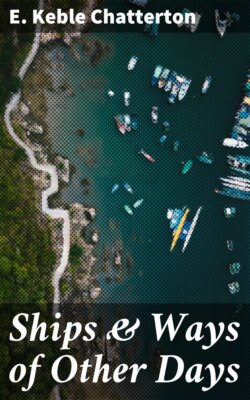Ships & Ways of Other Days

Реклама. ООО «ЛитРес», ИНН: 7719571260.
Оглавление
E. Keble Chatterton. Ships & Ways of Other Days
Ships & Ways of Other Days
Table of Contents
CHAPTER I. INTRODUCTION
CHAPTER II. THE BIRTH OF THE NAUTICAL ARTS
CHAPTER III. THE DEVELOPMENT OF THE MARINE INSTINCT
CHAPTER IV. MEDITERRANEAN PROGRESS
CHAPTER V. ROME AND THE SEA
CHAPTER VI. THE VIKING MARINERS
CHAPTER VII. SEAMANSHIP AND NAVIGATION IN THE MIDDLE AGES
CHAPTER VIII. THE PERIOD OF COLUMBUS
CHAPTER IX. THE EARLY TUDOR PERIOD
CHAPTER X. THE ELIZABETHAN AGE
CHAPTER XI. THE SEVENTEENTH CENTURY
CHAPTER XII. THE EIGHTEENTH CENTURY
CHAPTER XIII. THE NINETEENTH CENTURY
GLOSSARY
INDEX
FOOTNOTES
Отрывок из книги
E. Keble Chatterton
Published by Good Press, 2019
.....
All oars were worked together against the tholes, and as we know from the old depictions there was a space left both at bow and stern beyond the oarsmen, this space being called the parexeiresia. The number of oarsmen just mentioned may seem very large, but having regard to the speed required for manœuvring and for ramming effectively it is not excessive. But when a war-vessel was employed on transport duty so great a host of men was not essential. In the case of a vessel engaged, for instance, in carrying horses in her hold only sixty oarsmen were needed. Had you found yourself alongside one of the war-galleys you would have been struck by its length and leanness more than by anything else. As you passed round by the bows you would have observed the two great eyes, one on either side of the hull, through which in all probability the hawsers passed. Behind these two eyes were very substantial catheads which projected like great ears from the ship, and were used primarily for slinging the anchors just as in the old-fashioned sailing ships of Nelson and after; but, secondly, for convenience when ramming. Thus, when the terrible shock came, the catheads would protect the oars of the ship from damage and allow the utmost speed to be maintained till the last minute—a factor that was naturally of the highest importance. But also they were sometimes strengthened with supports so that they might catch in the topsides of the enemy and do him considerable damage.
As to the ram, which was the pivot of all the ancient naval tactics, there was one projecting spur below, but above it was another ram to catch the attacked ship at a second place. These rams were made of bronze and had three teeth; or if not made of bronze they were of wood sheathed with that metal. The stempost in these craft rose high in the air, and each ship had a distinguishing sign consisting either of a figurehead or some relief or painting at the bows. Of the two kinds of sails which these vessels carried, the larger was put ashore prior to battle, and only the smaller one retained. And as there were two sizes of sails, so there were two sizes of masts to correspond. Besides the halyards, brailing ropes, cables, braces, sheets, and forestay already alluded to, there were also backstays to support the masts. This was up to about the year 400 B.C., but, at any rate, by 330 B.C. triremes had simply mast, yard, sail, ropes, and the loops of brailing ropes, a simplified form of the earlier brails.
.....